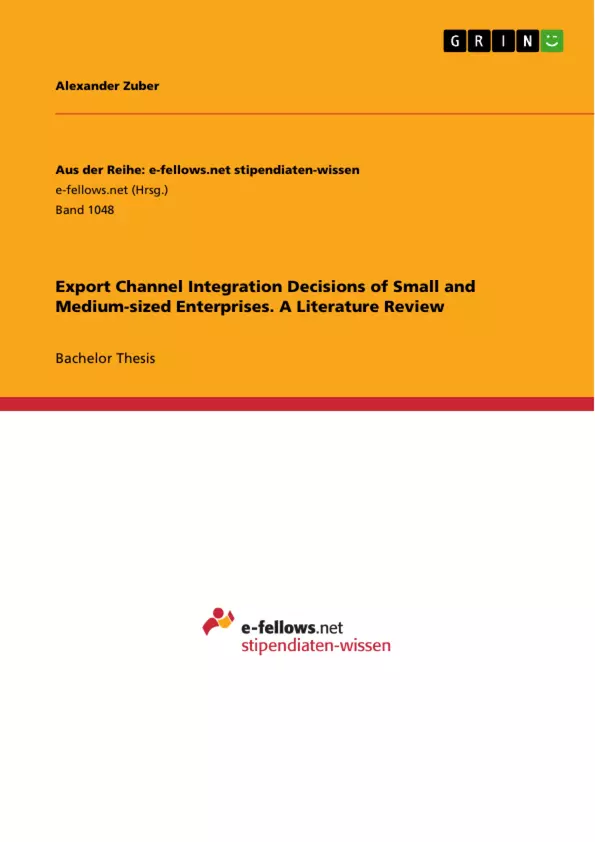“The opportunities for channel researchers to contribute to knowledge creation in the marketing discipline and, at the same time, affect business practice are almost endless” (Frazier 1999, p.238). While the theoretical understanding of the internationalization and international marketing strategies of large firms has been in the focus of research since a long time, attention has been given only recently to investigate the same questions for small and medium-sized enterprises (SMEs). Exporters need to question their export channel structure every day in order to remain successful. Should the product be distributed directly or indirectly? Which way is more efficient, effective and/or profitable? Should export channels be changed? (John & Weitz 1988, Huan & Hsu 2003). The decision on channel integration, the extent to which the export channel is performed by the exporting firm without intermediaries, is extremely important, as it affects revenues, investments and costs (Shervani, Frazier & Challagalla 2007). As a research field, export channel structure is vital for two groups. First, there are scholars trying to find evidence for applied theories, and second, managers attempting to reduce risks and improve export performance. Wrong decisions in export channel choice may incur high costs and long-lasting difficulties, particularly for SMEs. These firms, if active in international exporting, tend to rely on one or few export channels. At the same time, SMEs operate the majority of export channels worldwide and are more inclined to switch their export channels than multinational firms.
The first export channel research started in the 70s. Since then considerable progress has been made. Especially in the late 80s and early 90s researchers have focused on the structure of international distribution channels with increasing attention to SMEs. Several theories (Transaction Cost Economics (TCE), Internationalization Theory, and Resource-based View (RBV)) have been developed and applied to assess and explain the reasons of different export channel integration strategies. Within the research scope, although TCE is not complete to explain the different strategies with regard to the degree of channel integration, it has been by far the most popular theory applied to this question. The results of the relevant empirical studies point out that channel structure control, knowledge and experience are the most important factors.
Inhaltsverzeichnis (Table of Contents)
- Introduction
- Definitions
- Exporting
- Definition and Characteristics of Small and Medium-Sized Enterprises
- Theories Explaining Export Channel Choice of Small- and Medium-Sized Enterprises
- Transaction Cost Economics (TCE)
- Internationalization Theory (Uppsala Model)
- Resource-based View (RBV)
- Minor Theories
- Production (Cost) Theory
- Agency Theory
- Eclectic Paradigm Model
- Institutional Theory
- Psychic Distance
- Discussion
- Dependent Variables [Direct (integrated) vs. Indirect (independent)]
- Independent Variables
- External Uncertainties
- Asset Specificity
- Channel Volume and Export Intensity
- Existing Channel
- Market Similarity and Industry Characteristics
- Firm Size and Characteristics (Sales/Employees)
- Internal Uncertainties
- Decision Makers
- International Experience
- Customer Service (Intensity) and Non-Selling Activities
- Control Variables
- Distribution of Multiple Product Lines
- Distribution Costs
- Ownership Mode
- Moderator Variable
- Market Power of the Firm
- Conclusion and Implications
Zielsetzung und Themenschwerpunkte (Objectives and Key Themes)
This bachelor thesis aims to provide a comprehensive overview of the current literature on export channel integration decisions of Small and Medium-Sized Enterprises (SMEs). It analyzes various theoretical frameworks and empirical studies to understand the factors influencing SMEs' choice of direct or indirect export channels.- The role of transaction cost economics, internationalization theory, and the resource-based view in explaining export channel integration choices of SMEs.
- The influence of internal and external uncertainties on export channel structure decisions.
- The impact of firm size, experience, and resources on the choice of direct versus indirect export channels.
- The significance of asset specificity, channel volume, and market characteristics in export channel integration decisions.
- The role of control variables and moderator variables in shaping SMEs' export channel strategies.
Zusammenfassung der Kapitel (Chapter Summaries)
- Introduction: This chapter introduces the topic of export channel integration decisions, highlighting the importance of channel structure for SMEs' success in international markets. It emphasizes the need for research into the factors influencing channel integration choices, particularly for SMEs, which represent a large share of exporters globally.
- Definitions: This chapter provides definitions of key concepts related to the study, including exporting and the characteristics of Small and Medium-Sized Enterprises (SMEs). It establishes a common understanding of the terms used throughout the thesis.
- Theories Explaining Export Channel Choice of Small- and Medium-Sized Enterprises: This chapter delves into various theoretical frameworks used to understand the export channel choices of SMEs. It examines the contributions of Transaction Cost Economics (TCE), Internationalization Theory (Uppsala Model), and the Resource-based View (RBV) to explaining channel integration decisions. The chapter also briefly discusses other theories that have been applied in this context, such as Production (Cost) Theory, Agency Theory, the Eclectic Paradigm Model, Institutional Theory, and the concept of Psychic Distance.
- Discussion: This chapter explores the key variables influencing SMEs' export channel integration choices. It examines both dependent and independent variables, including external uncertainties, asset specificity, channel volume, existing channels, market similarity, firm size, internal uncertainties, decision makers, international experience, customer service, and various control and moderator variables.
Schlüsselwörter (Keywords)
The main keywords and focus topics of this text include: export channel integration, Small and Medium-Sized Enterprises (SMEs), transaction cost economics, internationalization theory, resource-based view, external uncertainties, internal uncertainties, asset specificity, channel volume, market characteristics, firm size, and international experience.- Quote paper
- Alexander Zuber (Author), 2013, Export Channel Integration Decisions of Small and Medium-sized Enterprises. A Literature Review, Munich, GRIN Verlag, https://www.grin.com/document/284626



